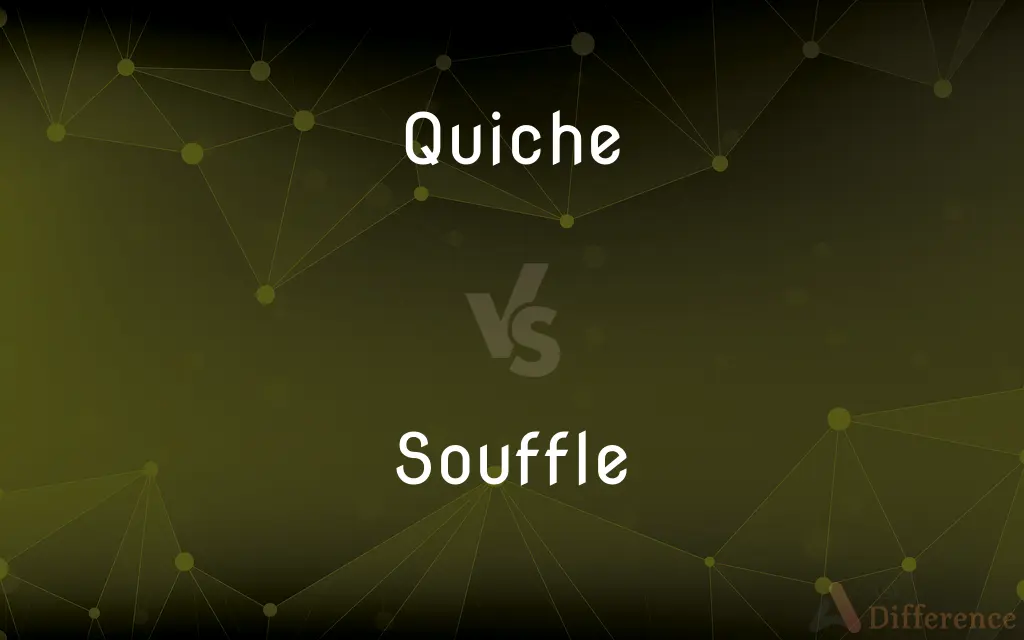Quiche vs. Souffle — What's the Difference?
By Tayyaba Rehman & Maham Liaqat — Updated on March 11, 2024
Quiche is a savory pie with a filling of eggs, cream, and cheese, often enriched with meats or vegetables. Souffle is a light, fluffy dish made from egg yolks and beaten egg whites combined with various other ingredients.

Difference Between Quiche and Souffle
Table of Contents
ADVERTISEMENT
Key Differences
Quiche is known for its rich, custard-like filling and flaky pastry crust, making it a hearty and versatile dish. It originates from France and can be served hot or cold, often featuring a variety of meats, vegetables, and cheeses. Souffle, on the other hand, is celebrated for its airy and delicate texture, achieved by folding flavored egg yolks into stiffly beaten egg whites. This culinary creation also hails from France and requires precise timing and technique to maintain its iconic rise.
The preparation of quiche involves a pastry crust that is pre-baked and then filled with a mixture of eggs, cream, and cheese, along with optional ingredients like bacon, spinach, or mushrooms. The entire dish is then baked until the filling is set. In contrast, a souffle is made by combining a flavorful base, often a béchamel sauce or pureed ingredients, with egg yolks, and then gently folding in beaten egg whites. The mixture is baked in a ramekin or souffle dish until it puffs up and becomes golden brown.
Quiche can be enjoyed as a main dish or a side, often seen in brunch menus or as a light dinner option. Its robust structure allows it to be easily transported, making it a popular choice for picnics and potlucks. Souffle, with its delicate structure, is typically served immediately after baking to preserve its lofty texture, making it a more ephemeral and often more formal dining experience.
The texture of quiche is dense and creamy, with a contrast provided by the crisp pastry crust. This combination of textures makes it a satisfying meal. Souffle's texture is its defining feature: airy, light, and soft, it almost seems to melt in the mouth, offering a unique eating experience that highlights the flavors of its ingredients.
Quiche's versatility extends to its ingredients, allowing for a wide range of flavors and combinations, from classic Lorraine with bacon and cheese to vegetarian options filled with seasonal vegetables. Souffle, while also adaptable in terms of flavor, ranging from savory cheese or spinach to sweet chocolate or lemon, demands more precision in its ingredient ratios and cooking technique to achieve the perfect rise and texture.
ADVERTISEMENT
Comparison Chart
Base
Pastry crust
Egg yolks combined with béchamel or purees
Texture
Dense and creamy with a crisp crust
Airy and light
Main Ingredients
Eggs, cream, cheese, optional meats or vegetables
Egg yolks and whites, flavoring ingredients
Serving Temperature
Hot or cold
Hot, immediately after baking
Preparation Complexity
Moderate, with flexibility in ingredients
High, requires precise technique for egg whites
Compare with Definitions
Quiche
A savory pie filled with a custard made from eggs, cream, and cheese.
She made a spinach quiche for brunch.
Souffle
A light, fluffy dish made by folding beaten egg whites into a flavored base.
He impressed his guests with a chocolate souffle for dessert.
Quiche
Often includes additional ingredients such as meats, vegetables, or herbs.
The bacon and leek quiche was a hit at the party.
Souffle
Requires precise technique and timing for the perfect rise.
She carefully folded the egg whites into the base to ensure her souffle would rise.
Quiche
Originates from France but has gained popularity worldwide.
Quiche Lorraine, with its bacon and cheese filling, is a classic French dish.
Souffle
Can be savory or sweet, depending on the added ingredients.
For dinner, they had a cheese souffle as the main course.
Quiche
Features a flaky pastry crust that encases the filling.
Her homemade quiche had a perfectly golden, buttery crust.
Souffle
Must be served immediately to maintain its height and texture.
As soon as the souffle was ready, it was brought to the table to avoid deflation.
Quiche
Can be served hot or cold, making it versatile for various meals.
For a picnic, she packed a cold ham and cheese quiche.
Souffle
Originates from France, known for its delicate texture.
The restaurant's specialty was a classic French souffle with a hint of truffle.
Quiche
Quiche ( KEESH) is a French tart consisting of pastry crust filled with savoury custard and pieces of cheese, meat, seafood or vegetables. The best-known variant is quiche Lorraine, which includes lardons or bacon.
Souffle
A light, fluffy baked dish made with egg yolks and beaten egg whites combined with various other ingredients and served as a main dish or sweetened as a dessert.
Quiche
A rich unsweetened custard pie, often containing ingredients such as vegetables, cheese, or seafood.
Souffle
Alternative spelling of soufflé
Quiche
A member of a Mayan people of Guatemala.
Souffle
(medicine) A murmuring or blowing sound.
The uterine souffle heard over the pregnant uterus
Quiche
The Mayan language of the Quiché.
Souffle
A murmuring or blowing sound; as, the uterine souffle heard over the pregnant uterus.
Quiche
A pie made primarily of egg and cream, perhaps mixed with chopped meat or vegetables, in a pastry crust.
Souffle
A side dish served hot from the oven at dinner, made of eggs, milk, and flour or other farinaceous substance, beaten till very light, and flavored with fruits, liquors, or essence.
Quiche
A member of the Mayan people of south central Guatemala
Souffle
Decorated with very small drops or sprinkles of color, as if blown from a bellows.
Quiche
A tart filled with rich unsweetened custard; often contains other ingredients (as cheese or ham or seafood or vegetables)
Souffle
Light fluffy dish of egg yolks and stiffly beaten egg whites mixed with e.g. cheese or fish or fruit
Quiche
The Mayan language spoken by the Quiche people
Common Curiosities
Can quiche be eaten as a main course?
Yes, quiche can serve as a filling main course, especially when paired with a salad or vegetables.
Are there sweet versions of quiche and souffle?
Quiche is typically savory, but souffle can be both savory and sweet.
Do both dishes originate from France?
Yes, both quiche and souffle have French origins.
Can both quiche and souffle be made in advance?
Quiche can be made in advance and served cold or reheated, whereas souffle should be served immediately after baking for best results.
Is souffle considered a difficult dish to make?
Yes, souffle is known for its culinary challenge, particularly in achieving its signature rise.
What are popular souffle flavors?
Popular souffle flavors include cheese, chocolate, and lemon.
Can quiche be frozen?
Yes, quiche can be frozen either before or after baking, making it a convenient make-ahead dish.
Can dietary restrictions be accommodated with these dishes?
Yes, both quiche and souffle recipes can be adapted to meet various dietary needs, such as using gluten-free crusts or dairy substitutes.
What is the main difference between quiche and souffle?
The main difference is in their structure: quiche has a custard filling with a pastry crust, while souffle is a light, airy dish made from egg whites.
Does souffle always require a ramekin?
While traditionally baked in a ramekin, souffles can also be prepared in other oven-safe dishes, though the shape and size may affect the cooking time.
What are common flavors for quiche?
Common quiche flavors include Lorraine (bacon and cheese), spinach, and mushroom.
Is there a vegetarian version of quiche?
Yes, there are many vegetarian quiche options that use vegetables and cheese.
Are there any common mistakes to avoid when making souffle?
Common mistakes include under or over-beating the egg whites and opening the oven door too early, which can cause the souffle to fall.
What is the key to a successful souffle rise?
The key is in properly beaten egg whites and gentle folding to retain air bubbles.
How long does it take to prepare quiche and souffle?
Quiche preparation might take longer due to crust preparation and baking time, whereas souffle requires less prep time but needs immediate attention when baking.
Share Your Discovery

Previous Comparison
Sverige vs. Sweden
Next Comparison
Elderberry vs. PokeweedAuthor Spotlight
Written by
Tayyaba RehmanTayyaba Rehman is a distinguished writer, currently serving as a primary contributor to askdifference.com. As a researcher in semantics and etymology, Tayyaba's passion for the complexity of languages and their distinctions has found a perfect home on the platform. Tayyaba delves into the intricacies of language, distinguishing between commonly confused words and phrases, thereby providing clarity for readers worldwide.
Co-written by
Maham Liaqat













































